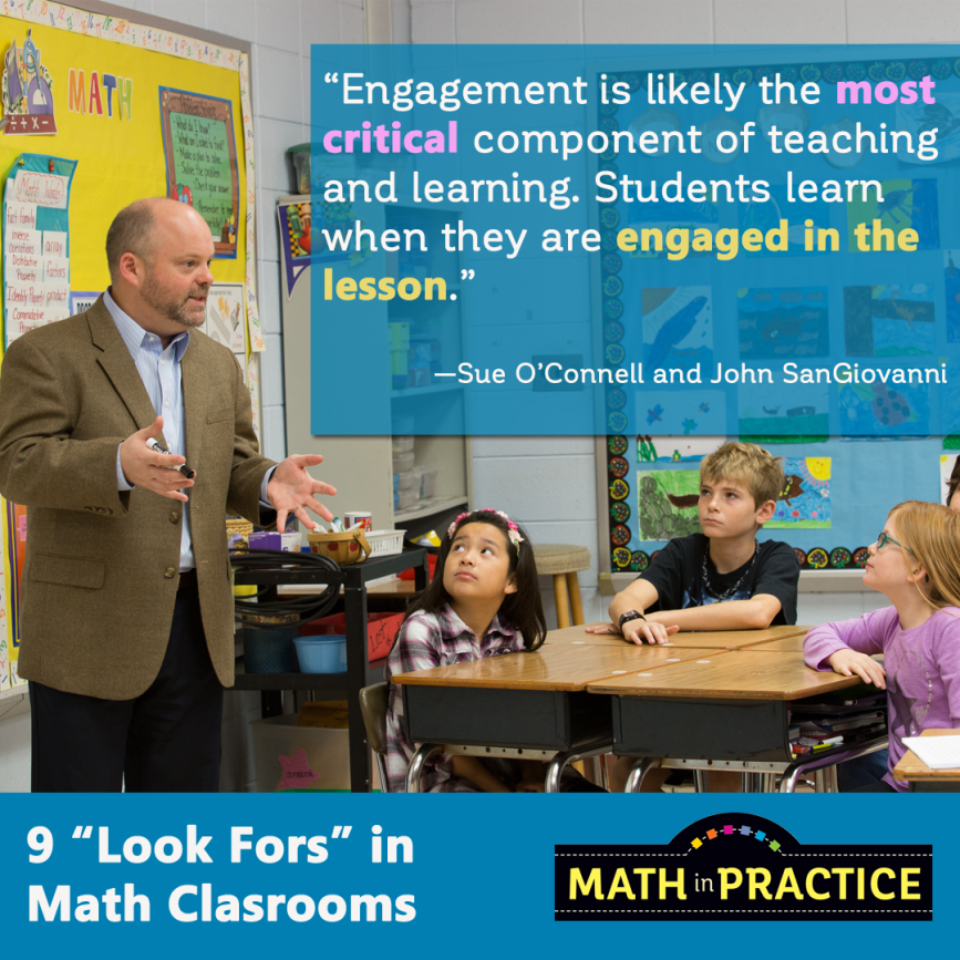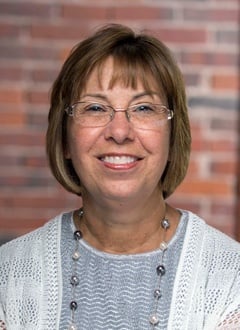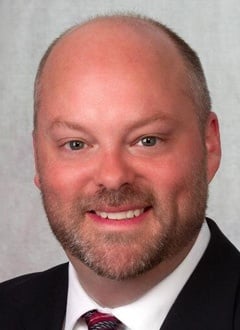
By Sue O’Connell and John SanGiovanni, adapted from A Guide for Administrators, from Math in Practice.
What do we hope to see and hear when we step into a math classroom? As our focus has shifted from memorizing to understanding and from calculating to applying, we have recognized instructional strategies that are better suited to these goals.
As we observe math classrooms, we look for evidence that teaching is more than delivering a textbook lesson. We look at the interactions between teacher and students, the on-the-spot decisions made by the teacher to keep learning progressing, and the ways in which the teacher brings math ideas to light through talk, visuals, and making connections to past learning. More specifically, here are some key features we would hope to see in an effective math classroom.
1. Look for a clear focus on math standards
Without a clear focus on the standard being addressed, teaching can get side-tracked. Teachers and students should be aware of the standard, or standards, that drive the lesson, as well as the connection to standards addressed in previous grades.
- What standard is being addressed?
- Is the standard appropriate for the grade level and conveyed in student-friendly terms?
- Do the activities and teaching strategies focus on the standard?
- Is there evidence of both process and content standards being addressed?
- What connections are being made to standards addressed in previous grades?
2. Look for students actively engaged in learning
Engagement is likely the most critical component of teaching and learning. Students learn when they are engaged in the lesson.
- Are the math tasks high-quality and worthwhile?
- Are teachers guiding the explorations, allowing students to think for themselves?
- Are all students answering questions (e.g., are turn and share strategies being used rather than one student answering the question)?
- Are students allowed time for productive struggle? Are they praised for effort and perseverance?
3. Look for deep and focused teacher questioning
Through deep questions teachers are able to probe, scaffold, and extend students’ thinking.
- What is the depth of teacher questioning? Are teachers going beyond asking for answers to asking for explanations and justifications? Does the teacher ask probing questions (e.g., Why? How? What if…? What does that mean? Will that always work?) to stimulate students’ thinking?
- Does the teacher ask questions that channel students’ thinking to a specific understanding or insight?
- Is time given for students to formulate their ideas (e.g., wait time or partner discussions)?
4. Look for communication about math ideas
It is through talk that students develop mathematical reasoning and problem-solving skills, process their own ideas, hear the ideas of others, and extend and refine their own mathematical thinking.
- What does the teacher talk sound like? Is the teacher using think-alouds, revoicing students’ ideas, clarifying concepts with examples, and making connections?
- What does the student talk sound like? Do students have frequent opportunities to explain and justify their thinking? Are student-to-student conversations encouraged?
- Are students encouraged to discuss and share observations and insights about math investigations?
- Are students pushed to elaborate on their thinking and to comment on others’ ideas?
- Is precision expected when students talk about math? Are students being asked to use appropriate math terms and precisely explain their thinking?
- Is flawed reasoning investigated and discussed?
5. Look for posing and solving problems as an integral part of math instruction
Problem solving should not be seen as an afterthought – something we do at the end of a lesson. Problems should be integrated into all parts of lessons. Connections to real situations through problem contexts helps students make sense of math skills and understand when and how to apply the skills.
- Are connections made between math skills and real situations?
- Are problems integrated into skills teaching to set a context for math skills and concepts?
- Do students discuss strategies for comprehending and making sense of problems?
- Is modeling problems with manipulatives or drawings encouraged?
- Do students have the opportunity to share, discuss, and explain their varied strategies, and justify their solutions?
6. Look for a focus on building understanding
Understanding math concepts and procedures is foundational. Through investigations, representations, and math talk we help students build a solid foundation. For example, rather than teaching computation skills as a step-by-step process to memorize, we first explore the skills using visual models and strategies based on our understanding of place value, operations, and properties. Then, the steps of the procedure make sense.
- Are lessons focused on developing understanding, not just memorizing?
- Are flexible strategies encouraged and do discussions occur to connect those strategies to a basic understanding of numbers and operations?
- Are students encouraged to use tools (e.g., hands-on materials, paper/pencil, hundred charts, number lines…) as they explore math ideas?
- Are models and math talk used to promote understanding?
7. Look for varied representations of math thinking
Students learn about math by creating models of math concepts and processes. They benefit from opportunities to visualize math ideas through manipulatives, drawings, acting out situations, as well as using abstract numbers and symbols. These varied representations help them develop insights about the big ideas being explored.
- Does the teacher include visual models when discussing math ideas and demonstrating math skills and concepts?
- Are students expected to model math ideas and share and explain their models?
- Are manipulatives readily available for student use?
- Does the teacher facilitate discussions that compare and contrast varied representations?
- Are connections made between symbolic representations and visual models?
8. Look for assessment as an integral part of instruction
Through ongoing assessment, information is gathered about what students know and are able to do allowing math instruction to be modified to meet their needs. Is formative assessment evident?
- Is the teacher gathering evidence of student understanding during instruction? Are opportunities built into the lesson that allow the teacher to check for understanding?
- Is the teacher making on-the-spot decisions based on what students are saying or doing? Is the teacher posing questions to probe or extend thinking, revisiting skills or clarifying ideas, or pulling small groups of students to reteach or enrich?
9. Look for attention to the needs of diverse students.
Not all learners in our classrooms have the same prior knowledge or learn math in the same way or at the same pace. Is there attention to the needs of all learners?
- Is the teacher attending to different skill levels within the classroom? Are modifications in the task or teaching evident (e.g., to remediate or enrich learning)?
- Do some students need, and receive, additional support through small groups or adjusted pacing?
- Are tools available to support the success of some students?
Math in Practice has been crosswalked with popular math programs and organized by grade level (K-5) so you can see—unit-by-unit and lesson-by-lesson—how this resource supports teachers using these programs. Click here to access these crosswalks.

Sue O’Connell has decades of experience supporting teachers in making sense of mathematics and effectively shifting how they teach. A former elementary teacher, reading specialist, and math specialist, she is also a nationally known speaker and education consultant who currently directs Quality Teacher Development, an organization committed to providing outstanding math professional development for schools and districts across the country.

John SanGiovanni is an elementary mathematics supervisor in Howard County, Maryland, as well as the coauthor of the bestselling Putting the Practices Into Action and the Mastering the Basic Math Facts books. John is also an adjunct instructor and coordinator of the Elementary Mathematics Instructional Leader graduate program at McDaniel College, and a national consultant for curriculum and professional development. A frequent speaker at national conferences, John also currently serves on the Board of Directors for NCTM.


